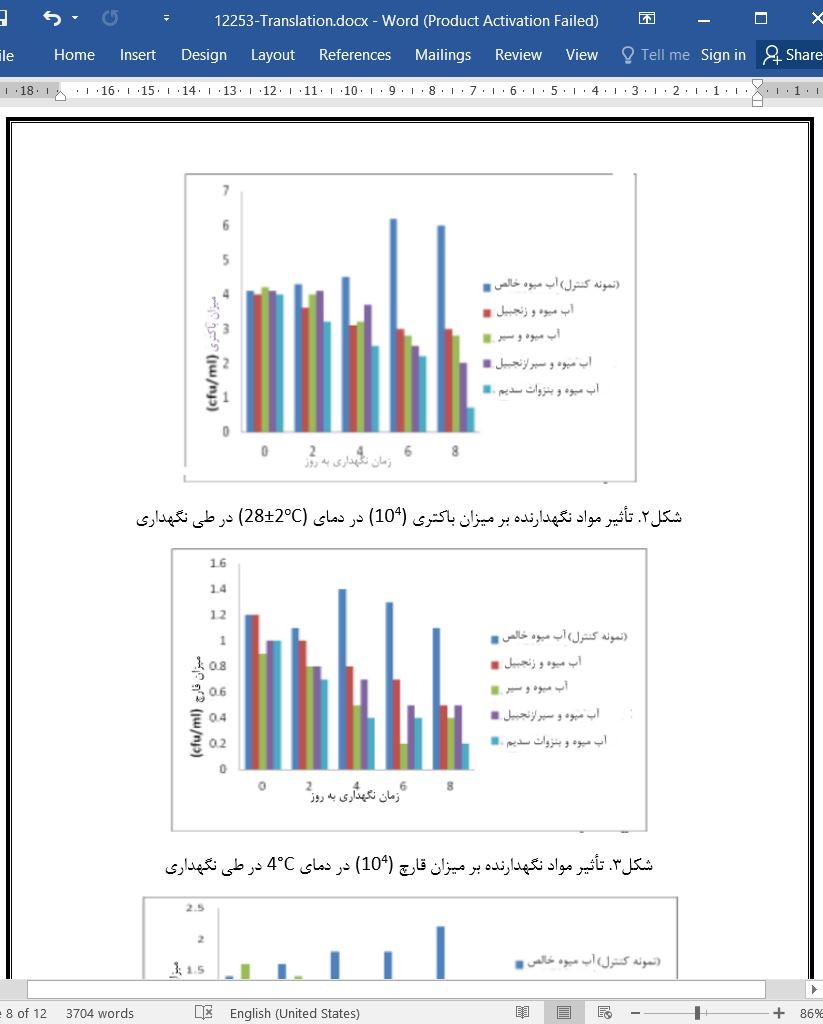
تاثیر مواد نگهدارنده طبیعی و مصنوعی و دمای نگهداری بر PH و بار میکروبی آب سیب
چکیده
آب سیب (Malus domestica) به ترتیب با 0.5 g/ml سیر، 0.5 g/mlزنجبیل، 0.25 g/ml مخلوط زنجبیل و سیر، و 0.05% (w/v) بنزوات سدیم عمل آوری شد، بطوریکه در آن زنجبیل ، سیر و بنزوات سدیم به عنوان مواد نگهدارنده طبیعی و مصنوعی مورد استفاده قرار گرفتند. اثرات آنها بر آب سیب در طی 8 روز ذخیره سازی در دمای 4 oC و در دمای اتاق (28±2oC) مورد بررسی قرار گرفت. تعداد میکروبها برای باکتری و قارچ در نمونههای عمل آوری شده با زنجبیل ، سیر و بنزوات سدیم به ترتیب از 4.0×104 تا 7.0×10 3 cfu/ml و از 1.0×104 تا 2.0×103 cfu/ml، و در آب سیب عمل آوری نشده از 1.2×104 تا 2.2×104 cfu/ml بود. آب میوه عمل آوری شده با بنزوات سدیم کمترین آلودگی میکروبی را داشت در حالیکه آب میوه عمل آوری نشده دارای بالاترین آلودگی میکروبی بود. مقادیر PH در سراسر عمل آوریهای آب سیب نگهداری شده تا حد ناچیزی کاهش یافته بود و آب میوه نگهداری شده در دمای 4 oC در مقایسه با آب میوه نگهداری شده در دمای اتاق، تغییر ناچیزی را در PH نشان داد. نتایج به دست آمده نشان میدهد که مواد نگهدارنده دارای اثر ضد میکروبی بر بار میکروبی هستند و pH تأثیر قابل توجهی در عمر نگهداری آب میوه دارد، زیرا بار میکروبی در حداقل میزان خود است و زمانیکه آن در دمای پایینی نگهداری شود، PH مانند اسیدیته رو به کاهش می گذارد.
مقدمه
درخت سیب (Malus domestica) یک درخت برگریز از خانواده گل رز است که میوۀ آن بخاطر شیرینی و گوشتالو بودن معروف است (GRIN، 2012) و طول آن در زمینهای کشاورزی از 1.8 تا 4.6 متر (6 تا 15 فوت) و نوع جنگلی آن تا 39 فوت (12 متر) میباشد (GRIN، 2012). این گیاه به عنوان یک درخت میوه در سراسر جهان کشت میشود و بیشترین گونه آن از نوع Malus است. در سال 2013 حدود 80 میلیون تن سیب در سراسر جهان تولید شد که نیمی از این میزان تولید مربوط به چین بود (FAO، 2015). ایالات متحده با دارا بودن بیش از 6٪ تولید جهانی دومین تولید کننده برتر است. سیبها اغلب بصورت خام خورده میشوند اما در بسیاری از غذاهای حاضری (به ویژه دسر) و نوشیدنیها نیز استفاده میشوند. این میوه در اواخر تابستان یا پاییز رسیده میشود و انواع مختلف آن در اندازههای مختلف وجود دارد. هدف تولیدکنندگان تجاری این است که با توجه به ترجیح بازار، سیبی با قطر 7.0 تا 8.3 سانتی متر (2.75 تا 3.25 اینچ) تولید کنند.
ABSTRACT
Apple (Malus domestica) juice was treated with 0.5 g/ml garlic, 0.5 g/ml ginger, 0.25 g/ml mix of ginger and garlic and 0.05% (w/v) of sodium benzoate respectively where the ginger, garlic and sodium benzoate serves as natural and artificial preservatives. Their effects on the apple fruit juice were evaluated during 8 days of storage at 4oC and at room temperature (28±2oC). The microbial counts ranged from 4.0×104 to 7.0×103 cfu/ml and from 1.0×104 to 2.0×103 cfu/ml for bacteria and fungi, respectively in the samples treated with ginger, garlic and sodium benzoate and from 1.2×104 to 2.2×104 cfu/ml in the apple juice without treatment. Juice treated with sodium benzoate had the least microbial contamination while the untreated juice had the highest. There was marginal decrease in pH values across treatments in stored apple juice with juice stored at 4 oC showing the least change in pH compared to that stored at room temperature. The results obtained show that the preservatives exhibited antimicrobial effect on the microbial load and that pH has a significant impact on the shelf-life of the fruit juice as the microbial load was least when stored at low temperature the pH as acidity tends to be inclined towards low pH.
INTRODUCTION
The apple tree (Malus domestica) is a deciduous tree in the rose family best known for its sweet, pomaceous fruit, the apple(GRIN, 2012) and stands1.8 to 4.6 m (6 to 15 ft) tall in cultivation and up to 39 ft (12 m) in the wild (GRIN, 2012). It is cultivated worldwide as a fruit tree, and is the most widely grown species in the genus Malus. About 80 million tons of apples were grown worldwide in 2013, and China produced almost half of this total (FAO, 2015). The United States is the secondleading producer, with more than 6% of world production. Apples are often eaten raw but can also be found in many prepared foods (especially desserts) and drinks. The fruit matures in late summer or autumn, and varieties exist with a wide range of sizes. Commercial growers aim to produce an apple that is 7.0 to 8.3 cm (2.75 to 3.25 in) in diameter, due to market preference.
چکیده
مقدمه
موضوعات و روشها
جمع آوری و فرآوری میوه
آماده سازی مواد افزودنی / نگهدارنده میوه
تولید آب سیب
عمل آوری آب سیب با مواد نگهدارنده طبیعی و شیمیایی
نگهداری نمونه
تجزیه و تحلیل میکروبیولوژیکی آب میوه
تعیین تعداد میکروبهای آب میوه
تعیین pH
نتایج و بحث
شمارش جمعیت میکروبی
تأثیر مواد نگهدارنده بر Ph در طی مدت نگهداری
نتیجه گیری
منابع
ABSTRACT
INTRODUCTION
MATERIALS AND METHODS
Collection and Processing of Fruit
Preparation of Fruit Additive/Preservative
Production of Apple Juice
Treatment of Apple Juice with Natural and Chemical Preservatives
Storage of Sample
Microbiological Analysis of Fruit Juice
Determination of microbial counts of the juice
Determination of Ph
RESULTS AND DISCUSSION
Microbial Population Counts
Effect of Preservatives on pH during Storage
CONCLUSION
REFERENCES
- اصل مقاله انگلیسی با فرمت ورد (word) با قابلیت ویرایش
- ترجمه فارسی مقاله با فرمت ورد (word) با قابلیت ویرایش، بدون آرم سایت ای ترجمه
- ترجمه فارسی مقاله با فرمت pdf، بدون آرم سایت ای ترجمه



